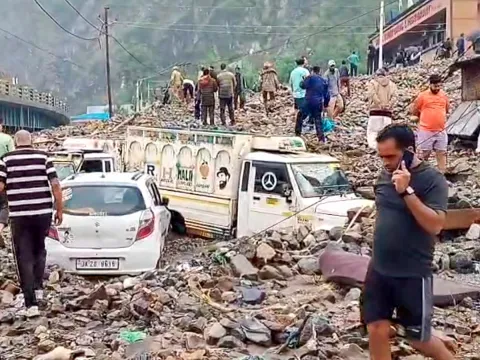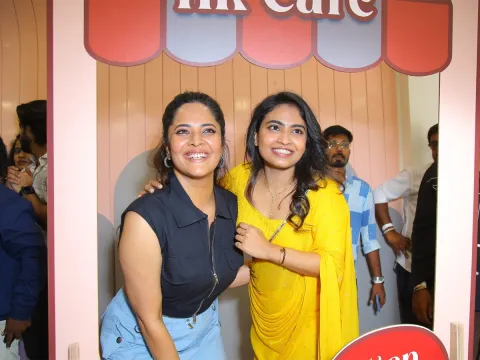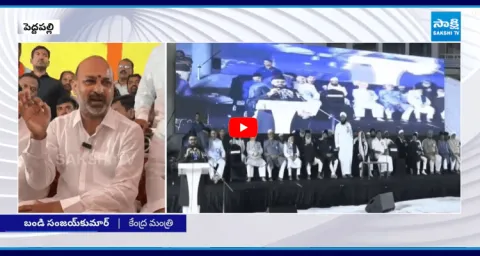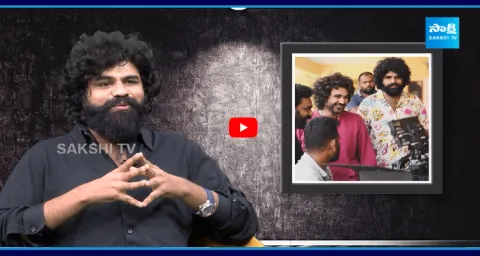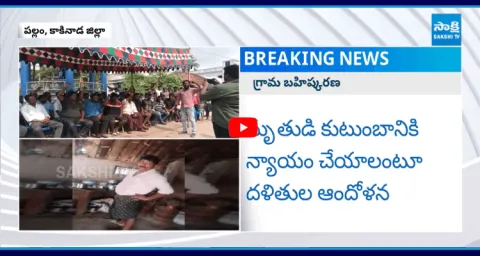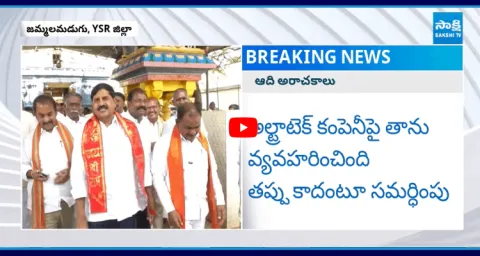సివిల్స్ ప్రిలిమ్స్ పేపర్-2 మోడల్ పేపర్ 'కీ'
(Continuation to yesterday's City Plus VIDYA )
Passage - 2
Cynthia was a shy girl. She believed that she was plain and untalented. One day her teacher ordered the entire class to show up for audition for the school play. Cynthia nearly died of fright when she was told that she would have to stand on stage in front of the entire class and deliver dialogues. The mere thought of it made her feel sick. But a remarkable transformation occurred during the audition. A thin, shy girl, her knees quaking, her stomach churning in terror, began to stun everyone with her excellent performance. Her bored classmates suddenly stopped their noisy chat to stare at her slender figure on the stage. At the end of her audition, the entire room erupted in thunderous applause.
41. Cynthia was afraid to stand on stage because
a) she felt her classmates may laugh at her.
b) her stomach was churning.
c) she lacked self-confidence.
d) she did not like school plays.
42. Cynthia's classmates were chatting because
a) it was their turn to act next.
b) they were bored of the performances.
c) Cynthia did not act well.
d) the teacher had no control over them.
43. Cynthia's knees were quaking because
a) she felt nervous and shy.
b) the teacher scolded her.
c) she was very thin and weak.
d) she was afraid of her classmates.
44. The transformation that occurred during the audition refers to
a) the nervousness of Cynthia.
b) the eruption of the entire room in thunderous applause.
c) the surprise on the faces of her classmates.
d) the stunning performance of Cynthia.
45. If the 3rd day of a month is Monday, which one of the following will be the fifth day from 21st of this month?
a) Monday b) Tuesday
c) Wednesday d) Friday
46. For a charity show, the total tickets sold were 420. Half of these tickets were sold at the rate of Rs. 5 each, one-third at the rate of Rs. 3 each and the rest for Rs. 2 each. What was the total amount received?
a) Rs.900 b) Rs.1,540
c) Rs.1,610 d) Rs.2,000
Directions for the following 3 (three) items:
Read the passage given below and answer the items that follow.
A, B, C, D, E, F are members of a family. They are engineer, stenographer, doctor, draughtsman, lawyer and judge (not in order). A, the engineer is married to the lady stenographer. The judge is married to the lawyer. F, the draughtsman is the son of B and brother of E. C, the lawyer is the daughter-in-law of D. E is the unmarried doctor. D is the grandmother of F. There are two married couples in the family.
47. What is the profession of B?
a) Judge b) Lawyer
c) Draughtsman
d) Cannot be determined
48. Which of the following is/are a couple/couples?
a) AD only b) BC only
c) Both AD and BC
d) Both AC and BD
49. What is the profession of D?
a) Judge b) Stenographer
c) Doctor d) Cannot be determined
Directions for the following 7 (seven) items:
Read the following two passages and answer the items that follow each passage. Your answers to these items should be based on the passages only.
Passage -1
Many nations now place their faith in capitalism and governments choose it as the strategy to create wealth for their people. The spectacular economic growth seen in Brazil, China and India after the liberalisation of their economies is proof of its enormous potential and success. However, the global banking crisis and the economic recession have left many bewildered. The debates tend to focus on free market operations and forces, their efficiency and their ability for self correction. Issues of justice, integrity and honesty are rarely elaborated to highlight the failure of the global banking system. The apologists of the system continue to justify the success of capitalism and argue that the recent crisis was a blip.
Their arguments betray an ideological bias with the assumptions that an unregulated market is fair and competent, and that the exercise of private greed will be in the larger public interest.
Few recognize the bidirectional relationship between capitalism and greed; that each reinforces the other. Surely, a more honest conceptualisation of the conflicts of interest among the rich and powerful players who have benefited from the system, their biases and ideology is needed; the focus on the wealth creation should also highlight the resultant gross inequity.
50. The apologists of the "Free Market System", according to the passage, believe in
a) market without control by government authorities.
b) market without protection by the government.
c) ability of market to self correct.
d) market for free goods and
services.
51. With reference to "ideological bias", the passage implies that
a) free market is fair but not competent.
b) free market is not fair but competent.
c) free market is fair and competent.
d) free market is neither fair nor biased.
52. "The exercise of private greed will be in the larger public interest" from the passage
1. refers to the false ideology of capitalism.
2. underlies the righteous claims of the free market.
3. shows the benevolent face of capitalism.
4. ignores resultant gross inequity.
Which of the statements given above is/are correct?
a) 1 only b) 2 and 3
c) 1 and 4 d) 4 only
Passage - 2
Net profits are only 2.2% of their total assets for central public sector undertakings, lower than for the private corporate sector. While the public sector or the State-led entrepreneurship played an important role in triggering India's industrialization, our evolving development needs, comparatively less-than-satisfactory performance of the public sector enterprises, the maturing of our private sector, a much larger social base now available for expanding entrepreneurship and the growing institutional capabilities to enforce competition policies would suggest that the time has come to review the role of public sector.
What should the portfolio composition of the government be? It should not remain static all times. The airline industry works well as a purely private affair. At the opposite end, rural roads, whose sparse traffic makes tolling unviable, have to be on the balance-sheet of the State. If the government did not own rural roads, they would not exist. Similarly, public health capital in our towns and cities will need to come from the public sector. Equally, preservation and improvement of forest cover will have to be a new priority for the public sector assets.
Take the example of steel. With near-zero tariffs, India is a globally competitive market for the metal. Indian firms export steel into the global market, which demonstrates there is no gap in technology. Indian companies are buying up global steel companies, which shows there is no gap in capital availability. Under these conditions, private ownership works best.
Private ownership is clearly desirable in regulated industries, ranging from finance to infrastructure, where a government agency performs the function of regulation and multiple competing firms are located in the private sector. Here, the simple and clean solution - government as the umpire and the private sector as the players is what works best. In many of these industries, we have a legacy of government ownership, where productivity tends to be lower, fear of bankruptcy is absent, and the risk of asking for money from the tax payer is ever present. There is also the conflict of interest between government as an owner and as the regulator. The formulation and implementation of competition policy will be more vigorous and fair if government companies are out of action.
53. According to the passage, what is/are the reason/reasons for saying that the time has come to review the role of public sector?
1. Now public sector has lost its relevance in the industrialization process.
2. Public sector does not perform satisfactorily.
3. Entrepreneurship in private sector is expanding.
4. Effective competition policies are available now.
Which of the statements given above is/are correct in the given context?
a) 1 and 3 only b) 2 only
c) 2, 3 and 4 only d) 1, 2, 3 and 4
54. According to the passage, rural roads should be in the domain of public sector only. Why?
a) Rural development work is the domain of government only.
b) Private sector cannot have monetary gains in this.
c) Government takes money from tax payers and hence it is the responsibility of government only.
d) Private sector need not have any social responsibility.
55. The portfolio composition of the government refers to
a) Public sector assets quality.
b) Investment in liquid assets.
c) Mix of government investment in different industrial sectors.
d) Buying Return on Investment yielding capital assets.
56. The author prefers government as the umpire and private sector as players because
a) Govt. prescribes norms for a fair play by the private sector.
b) Government is the ultimate in policy formulation.
c) Government has no control over private sector players.
d) None of the above statements is correct in this context
57. A question paper must have a question on one of the eight poets: A, B, C, D, E, F, G or H. The first four belong to the medieval period while the rest are considered modern poets. Generally, modern poets figure in the question paper in alternate years. Generally those who like H like G also; and those who like F like E also. The paper-setter does not like to ask about F as he has written a book on F, but he likes F. Last year, the paper contained a question on A. On the basis of the information given, this year's paper is most likely to contain a question on
a) C b) E c) F d) H
58. In a group of six women there are four dancers, four vocal musicians, one actress and three violinists. Girija and Vanaja are among the violinists while Jalaja and Shailaja do not know how to play on the violin. Shailaja and Tanuja are among the dancers. Jalaja, Vanaja, Shailaja and Tanuja are all vocal musicians and two of them are also violinists.
If Pooja is an actress, who among the following is certainly a dancer and a violinist ?
a) Jalaja b) Pooja
c) Shailaja d) Tanuja
59. The letters L, M, N, O, P, Q, R, S and T in their order are substituted by nine integers 1 to 9 but not in that order. 4 is assigned to P.
The difference between P and T is 5. The difference between N and T is 3. What is the integer assigned to N?
a) 7 b) 5 c) 4 d) 6
60. The number of deaths among the army personnel is 8 in 1000, but among the civilian population it is 20 per 1000. Which one of the following inferences can be drawn from this statement?
a) It is better to join the army.
b) The relationship is fortuitous.
c) Quality of Life Index is very high within the armed forces.
d) The groups cannot be compared due to their heterogeneity.
61. Given the statement: "Buses are the cause of more accidents than cars, and trucks cause fewer accidents than buses", which of the following conclusions can we draw?
a) There are more buses on the road than trucks.
b) Car drivers are more careful than bus drivers.
c) Truck drivers are more skilled than either car or bus drivers.
d) None of the above
62. "If political leadership fails to emerge, there is likelihood of military taking over power in developing countries. Radical student groups or labour may try to raise revolution but they are not likely to compete with the military. Military intervention, rule, and withdrawal from politics is closely related to a society's level of political development."
In the context of political development, the assumption in the above passage is that
a) political leadership is not an effective instrument.
b) military fills in political vacuum.
c) military intervention is inevitable for development.
d) None of the above
63. Four persons, Alok, Bhupesh, Chander and Dinesh have a total of Rs. 100 among themselves. Alok and Bhupesh between them have as much money as Chander and Dinesh between them, but Alok has more money than Bhupesh; and Chander has only half the money that Dinesh has. Alok has in fact Rs. 5 more than Dinesh has. Who has the maximum amount of money?
a) Alok b) Bhupesh
c) Chander d) Dinesh
64. Examine the following statements:
1. George attends Music classes on Monday.
2. He attends Mathematics classes on Wednesday.
3. His Literature classes are not on Friday.
4. He attends History classes on the day following the day of his Mathematics classes.
5. On Tuesday, he attends his Sports classes.
If he attends just one subject in a day and his Sunday is free, then he is also free on
a) Monday b) Thursday
c) Saturday d) Friday
65. In a row 'A' is in the 11th position from the left and 'B' is in the 10th position from the right. If 'A' and 'B' interchange, then 'A' becomes 18th from the left. How many persons are there in the row other than 'A' and 'B'?
a) 27 b) 26 c) 25 d) 24
66. Location of B is north of A and location of C is east of A. The distances AB and AC are 5 km and 12 km respectively. The shortest distance (in km) between the locations B and C is
a) 60 b) 13 c) 17 d) 7
67. Two cars start towards each other, from two places A and B which are at a distance of 160 km. They start at the same time 08 : 10 AM. If the speeds of the cars are 50 km and 30 km per hour respectively, they will meet each other at
a) 10:10 AM b) 10: 30 AM
c) 11: 10 AM d) 11:20 AM
Directions for the following
6 (six) items :
Read the following two passages and answer the items that follow each passage. Your answers to these items should be based on the passages only.
Passage -1
Climate change poses potentially devastating effects on India's agriculture. While the overall parameters of climate change are increasingly accepted - a 1°C average temperature increase over the next 30 years, sea level rise of less than 10 cm in the same period, and regional monsoon variations and corresponding droughts - the impacts in India are likely to be quite site and crop specific. Some crops may respond favourably to the changing conditions, others may not. This emphasizes the need to promote agricultural research and create maximum flexibility in the system to permit adaptations.
The key ingredient for "drought proofing" is the managed recharge of aquifers. To ensure continued yields of important staple crops (e.g. wheat), it may also be necessary to shift the locations where these crops are grown, in response to temperature changes as well as to water availability. The latter will be a key factor in making long term investment decisions.
For example, water runoff from the Himalayas is predicted to increase over the next 30 years as glaciers melt, but then decline substantially thereafter. It will be critical to provide incentives to plan for these large-scale shifts in agro-ecological conditions.
India needs to make long term investment in research and development in agriculture. India is likely to experience changed weather patterns in future.
68. Consider the following statements:
Climate change may force the shifting of locations of the existing crops due to
1. melting of glaciers.
2. water availability and temperature suitability at other locations.
3. poor productivity of crops.
4. wider adaptability of crop plants.
Which of the statements given above are correct?
a) 1, 2 and 3 b) 2 and 3 only
c) 1 and 4 only d) 1, 2, 3 and 4
69. According to the passage, why is it important to promote agricultural research in India?
a) To predict variations in monsoon patterns and to manage water resources
b) To make long term investment decisions for economic growth
c) To facilitate wider adaptability of crops
d) To predict drought conditions and to recharge aquifers
Passage - 2
It is essential that we mitigate the emissions of greenhouse gases and thus avoid some of the worst impacts of climate change that would take place in coming years and decades. Mitigation would require a major shift in the way we produce and consume energy. A shift away from overwhelming dependence on fossil fuels is now long overdue, but unfortunately, technological development has been slow and inadequate largely because government policies have not promoted investments in research and development, myopically as a result of relatively low prices of oil. It is now, therefore, imperative for a country like India treating the opportunity of harnessing renewable energy on a large scale as a national imperative. This country is extremely well endowed with solar, wind and biomass sources of energy. Where we have lagged, unfortunately, is in our ability to develop and to create technological solutions for harnessing these resources.
One particular trajectory for carrying out stringent mitigation of greenhouse gas emissions assessed by the Intergovernmental Panel on Climate Change (IPCC) clearly shows the need for ensuring that global emissions of greenhouse gases peak no later than 2015 and reduce rapidly thereafter. The cost associated with such a trajectory is truly modest and would amount, in the estimation of IPCC, to not more than 3 percent of the global GDP in 2030. In other words, the level of prosperity that the world would have reached without mitigation would at worst be postponed by a few months or a year at the most. This is clearly not a very high price to pay for protecting hundreds of millions of people from the worst risks associated with climate change. Any such effort, however, would require lifestyles to change appropriately also. Mitigation of greenhouse gas emissions is not a mere technological fix, and clearly requires changes in lifestyles and transformation of a country's economic structure, whereby effective reduction in emissions is brought about, such as through the consumption of much lower quantities of animal protein.^ The Food and Agriculture Organization (FAO) has determined that the emissions from the livestock sector amount to 18 percent of the total. The reduction of emissions from this source is entirely in the hands of human beings, who have never questioned the impacts that their dietary habits of consuming more and more animal protein are bringing about. Mitigation overall has huge co-benefits, such as lower air pollution and health benefits, higher energy security and greater employment.
70. According to the passage, which of the following would help in the mitigation of greenhouse gases?
1. Reducing the consumption of meat
2. Rapid economic liberalization
3. Reducing the consumerism
4. Modem management practices of livestock
Select the correct answer using the code given below
a) 1, 2 and 3 b) 2, 3 and 4
c) 1 and 3 only d) 2 and 4 only
71. Why do we continue to depend on the fossil fuels heavily?
1. Inadequate technological development
2. Inadequate funds for research and development
3. Inadequate availability of alternative sources of energy
Select the correct answer using the code given below:
a) 1 only b) 2 and 3 only
c) 1 and 3 only d) 1, 2 and 3
72. According to the passage, how does the mitigation of greenhouse gases help us?
1. Reduces expenditure on public health
2. Reduces dependence on livestock
3. Reduces energy requirements
4. Reduces rate of global climate change
Select the correct answer using the code given below:
a) 1, 2 and 3 b) 1, 3 and 4
c) 2, 3 and 4 d) 1 and 4 only
73. What is the essential message of the passage?
a) We continue to depend on fossil fuels heavily
b) Mitigation of the greenhouse gases is imperative
c) We must invest in research and development
d) People must change their lifestyle
74. There are 50 students admitted to a nursery class. Some students can speak only English and some can speak only Hindi. 10 students can speak both English and Hindi. If the number of students who can speak English is 21, then how many students can speak Hindi, how many can speak only Hindi and how many can speak only English?
a) 21, 11 and 29 respectively
b) 28, 18 and 22 respectively
c) 37, 27 and 13 respectively
d) 39, 29 and 11 respectively
75. A gardener increased the area of his rectangular garden by increasing its length by 40% and decreasing its width by 20%. The area of the new garden
a) has increased by 20%.
b) has increased by 12%.
c) has increased by 8%.
d) is exactly the same as the old area.
76. Six books are labelled A, B, C, D, E and F and are placed side by side. Books B, C, E and F have green covers while others have yellow covers. Books A, B and D are new while the rest are old volumes. Books A, B and C are law reports while the rest are medical extracts. Which two books are old medical extracts and have green covers ?
a) B and C b) E and F
c) C and E d) C and F
77. A straight line segment is 36 cm long. Points are to be marked on the line from both the end points. From each end, the first point is at a distance of 1 cm from the end, the second point is at a distance of 2 cm from the first point and the third point is at a distance of 3 cm from the second point and so on. If the points on the ends are not counted and the common points are counted as one, what is the number of points?
a) 10 b) 12 c) 14 d) 16
78. If Sohan, while selling two goats at the same price, makes a profit of 10% on one goat and suffers a loss of 10% on the other
a) he makes no profit and no loss.
b) he makes a profit of 1%.
c) he suffers a loss of 1%.
d) he suffers a loss of 2%.
79. Out of a total of 120 musicians in a club, 5% can play all the three instruments, guitar, violin and flute. It so happens that the number of musicians who can play any two and only two of the above instruments is 30. The number of musicians who can play the guitar alone is 40. What is the total number of those who can play violin alone or flute alone?
a) 45 b) 44 c) 38 d) 30
80. Six identical cards are placed on a table. Each card has number '1' marked on one side and number '2' marked on its other side. All the six cards are placed in such a manner that the number '1' is on the upper side. In one try, exactly four (neither more nor less) cards are turned upside down. In how many least number of tries can the cards be turned upside down such that all the six cards show number '2' on the upper side?
a) 3 b) 5 c) 7
d) This cannot be achieved



